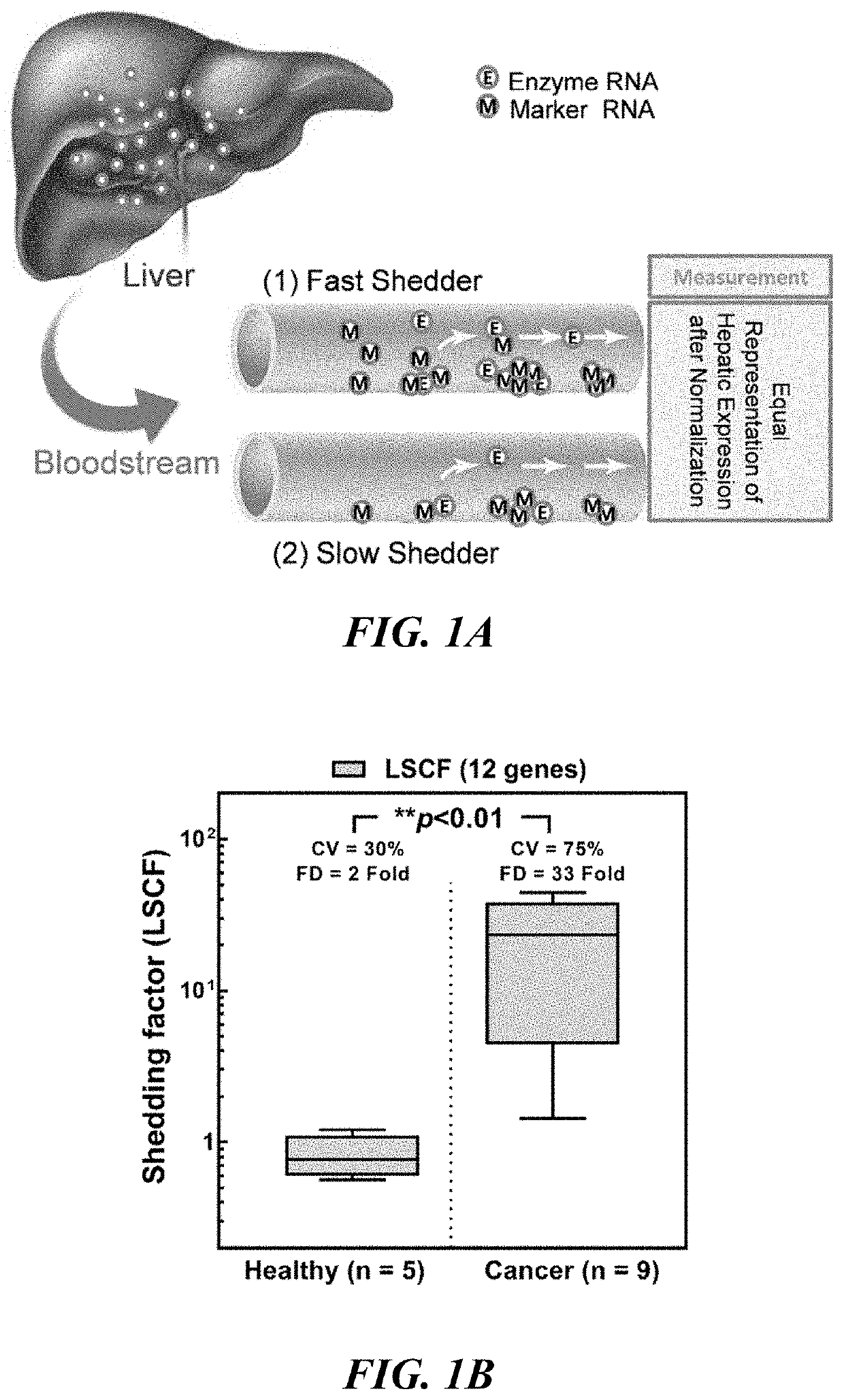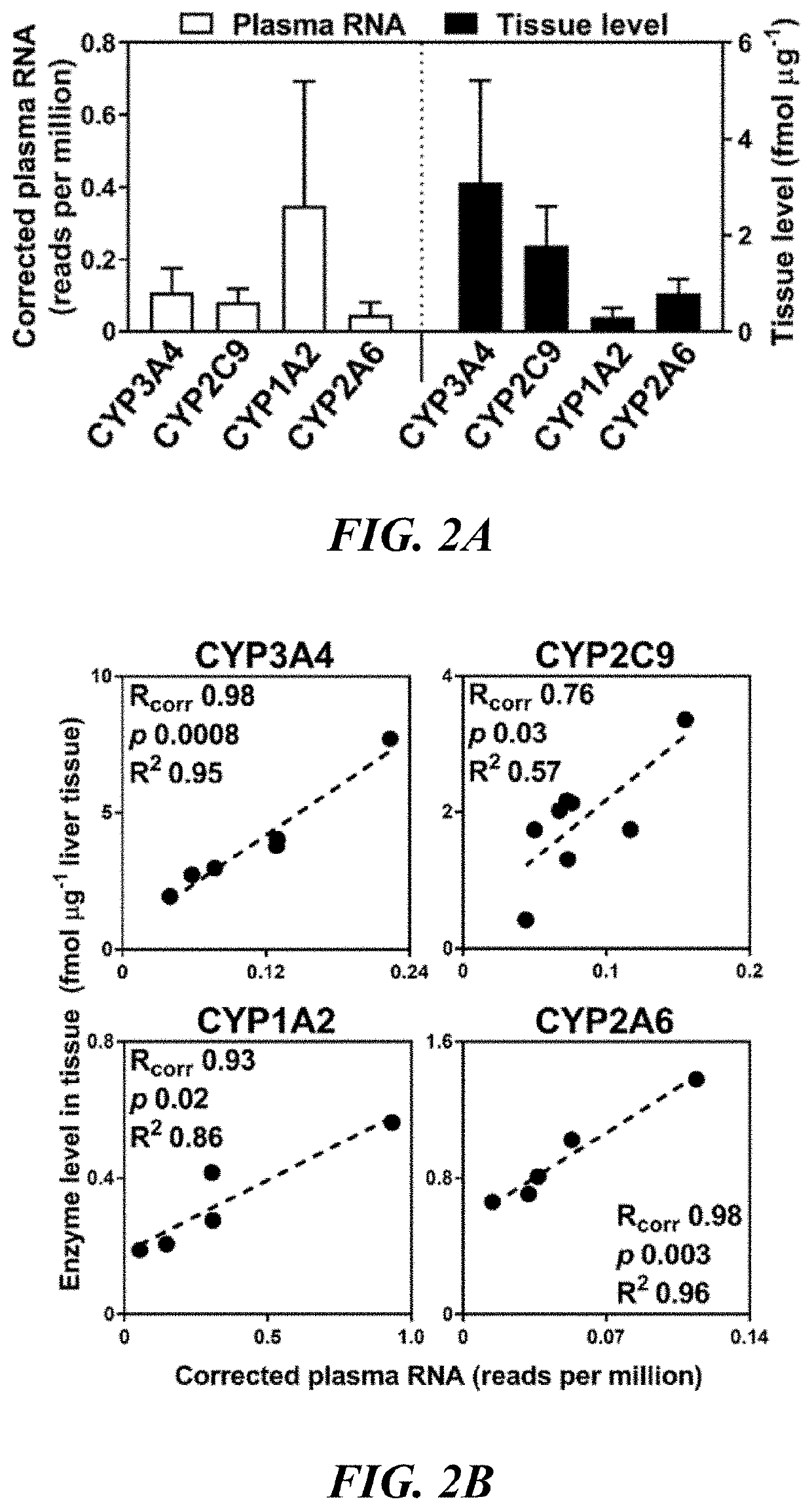Methods and apparatus for quantifying protein abundance in tissues via cell free ribonucleic acids in liquid biopsy
a liquid biopsy and protein abundance technology, applied in biochemistry apparatus and processes, instruments, ict adaptation, etc., can solve the problems of inability to predict variables, impracticality and potentially hazardous to expect individuals to be subjected to invasive biopsy procedures to harvest tissue, and ethically challenging to explore complex clinical scenarios
- Summary
- Abstract
- Description
- Claims
- Application Information
AI Technical Summary
Benefits of technology
Problems solved by technology
Method used
Image
Examples
example 1
[0152]The following example provides a protocol for determining the degree of RNA shedding into circulation from hepatocytes in a particular subject, so establishing a robust and significant correlation function between hepatic protein levels and the corresponding plasma RNA concentrations.
[0153]Selection of marker genes: A set of genes expressed principally in the organ (www.proteinatlas.orq) were selected and a panel of primers specific to their sequences were used to assess their expression levels in 20 blood samples from healthy individuals (2 female, age range 26-70 years) processed in three technical replicates (n=20×3). These genes were selected for being specifically expressed in the organ, at significantly high levels to be considered representative of organ shedding. Among the list of these genes, a number of genes (12) which are consistently detected in plasma samples were used as organ-specific plasma markers (Table 1), which together are proposed to make up an organ / tis...
example 2
[0160]Quantification of Drug Metabolizing Enzymes in Tissue Samples
[0161]Knowledge of the abundance of drug-metabolizing enzymes is essential for extrapolation of information on metabolic clearance (expressed per unit of enzyme) obtained from in vitro studies. Drug development requires optimization of pharmacokinetic properties, frequently based on prediction of in vivo behaviour from in vitro measurements. The absolute abundance level of hepatic drug-metabolizing enzymes can be determined by extrapolation of metabolism rates determined from recombinantly expressed enzymes to in vivo drug clearance, the so called IVIVE approach.
[0162]The quantification concatemer (QconCAT) technique was developed to quantify several proteins simultaneously in a sample and can be applied to drug-metabolizing enzymes and transporters to determine abundance levels in any given organ sample. The method involves an artificial protein comprising concatenated proteotypic signature peptides for a targeted s...
example 3
[0176]In order to determine that levels of circulating RNA for drug clearance enzymes which have been corrected for baseline shedding using an SCF as described in Example 1 above can be used to accurately estimate protein levels of the same enzymes in the organ, it is necessary to find tissue levels of these enzymes and compare them to RNA levels from the same subjects, for which the following protocol may be used.
[0177]Organ Tissue Processing
[0178]Differential centrifugation is used to isolate microsomal / crude membrane fractions. Loss due to fractionation is estimated using NADPH cytochrome P450 reductase activity (protein marker for the endoplasmic reticulum), and activity ratios allow recovery to be estimated and MPPGL (microsomal protein per gram organ) values to be calculated. Literature values for fractionation loss and MPPGL values may be found in the art (Barter Z., et al., (2007) Current Drug Metabolism; 8: 33-45). Protein recovery from homogenates was consistent across org...
PUM
| Property | Measurement | Unit |
|---|---|---|
| concentration | aaaaa | aaaaa |
| size | aaaaa | aaaaa |
Abstract
Description
Claims
Application Information
 Login to View More
Login to View More - R&D
- Intellectual Property
- Life Sciences
- Materials
- Tech Scout
- Unparalleled Data Quality
- Higher Quality Content
- 60% Fewer Hallucinations
Browse by: Latest US Patents, China's latest patents, Technical Efficacy Thesaurus, Application Domain, Technology Topic, Popular Technical Reports.
© 2025 PatSnap. All rights reserved.Legal|Privacy policy|Modern Slavery Act Transparency Statement|Sitemap|About US| Contact US: help@patsnap.com



